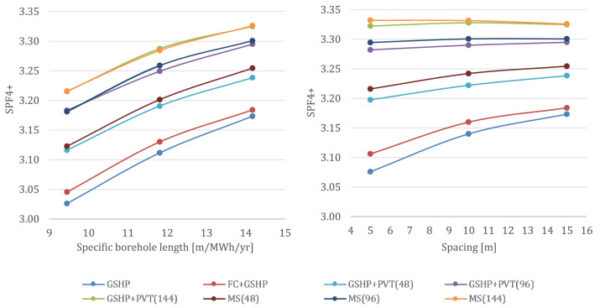Scientists from Sweden’s KTH Royal Institute of Technology have investigated the potential coupling of a ground source heat pump (GSHP) with both photovoltaic-thermal (PVT) energy and free cooling (FC).
“Based on the results, it makes sense to couple free cooling with PVT and heat pumps in cases in which the interference between the two systems is low,” corresponding author Dr. Francisco Beltrán told pv magazine. “The cooling demand has to be significantly lower than the heating demand; the free cooling heat exchanger should be located after the borehole field but before the PVT heat exchanger to minimize interference; and the PVT array needs to be carefully sized so it does not become over-dimensioned.”
In the context of ground source heat pump systems, free cooling utilizes the soil as a heat sink using only a heat exchanger and a circulation pump. “This approach allows the heat to be taken from indoor spaces to provide cooling while simultaneously regenerating the borehole heat exchanger,” the researchers explained.
In the proposed configuration of the so-called multi-source (MS) system, PVT and FC are utilized to regenerate ground temperature in the borehole. In unbalanced systems, ground temperature decreases over time due to heat extraction, reducing the overall system efficiency and causing the heat pump to shut down.
Using the simulation software, the researchers assessed the ideal placement of the FC in the system in a multi-family house in Stockholm.
“Since both the PVT and FC loops are competing against each other during the summer months to use the borehole field as a heat sink, it becomes necessary to do an interference analysis of the MS system for the three different system configurations,” they explained.

Image: KTH Royal Institute of Technology,Solar Energy Advances, CC BY 4.0 DEED
According to their finding, the ideal placement is between the borehole heat exchanger (BH) and the PVT, as it achieves an interference ratio of 0.89%. In comparison, placing the FC between the heat pump (HP) and the BH had a ratio of 12.2%, and placing it between the PVT and the HP had an interference of 19.25%.
“The results show that the most important factor that causes interference between the two systems is their relative placement in the system,” they highlighted. “However, this configuration reduces the thermal yield of the PVT collector by 7.24% compared to the PVT+GSHP case.”
The group compared the performance of the MS system with that of a GSHP alone, that of a GSHP using only FC, and that of a GSHP using only PVT. Other variables compared in the simulation were the number of boreholes the system uses (4-6), the spacing between them (5m-15m), and the number of modules on the PVT unit (0-144).
“Free cooling has a minimal impact on the seasonal performance factor (SPF) of the GSHP system, enhancing it at most by 0.7% for the smallest borehole field,” they stated. “On the other hand, the SPF4 of the GSHP+PVT systems gradually converges with that of a multi-source system as the number of PVT modules increases. This phenomenon arises because the proportion of heat injected by the PVT system becomes more significant relative to that of FC.”
Concluding their work, the research group assessed that the FC’s contribution to improving the SPF of the MS system is minimal compared to the contribution of PVT. “The only scenario studied where FC can reduce the land requirement is if the BH spacing is decreased to 10m, which leads to a reduction of 66.6% with a slightly lower SPF of 3.16 compared to 3.17 for GSHP-only,” they noted.
Their findings were presented in “Solar Photovoltaic/Thermal (PVT) Technology Collectors and Free Cooling in Ground Source Heat Pump Systems,” published in Solar Energy Advances. “The results demonstrate that the integration of PVT and FC not only maintains the cooling supply but also enhances heat pump performance, all the while reducing borehole length and land area requirements,” they concluded.
This content is protected by copyright and may not be reused. If you want to cooperate with us and would like to reuse some of our content, please contact: editors@pv-magazine.com.



Excellent briefing of advances in energy sector !